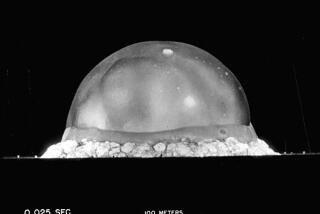BOOK REVIEW: SCIENCE : One Man’s Quest for Proof of the Big Bang : WRINKLES IN TIME, <i> by George Smoot and Keay Davidson</i> , William Morrow and Company Inc. $25, 331 pages
- Share via
Once upon a time not very long ago, cosmology--the study of the nature and origins of the universe--was a scientific specialty somewhere between theology and history. Great minds pondered the stars and applied mathematics to extrapolations from their observations about the size of the universe, its future and its past.
By the middle of this century, these great minds (and some lesser ones) had divided into two camps. Those in the first argued that there had been a creation, a “big bang” that brought forth space-time from a “singularity,” and that this space-time, our universe, has been expanding ever since. Such an enormous event, a pair of astronomers suggested in 1948, would have left an afterglow of background radiation.
Those in the second camp maintained that the universe has always been and will continue to exist in a steady state, operating under the same rules. To assume that the universe had a beginning, they argued, implies an end or a cooling down, and this they took as unacceptable. Besides, there was no evidence of any primal event.
Then in 1964, two researchers at Bell Labs, who had been investigating something entirely different, detected faint microwave radiation coming from all directions in the sky--the predicted afterglow of creation, and a boost to big-bang believers.
The discovery of background radiation occurred just as the sciences of particle physics and astronomy were merging into the new discipline of astrophysics. Giant accelerators here on Earth were producing some of the same particles that astronomers detected in space. Suddenly, cosmology had become an experimental science.
Enter George Smoot. “Wrinkles in Time” is Smoot’s memoir of his quest for evidence of the big bang, from the time he entered graduate school at MIT in 1970 through the success of COBE, the Cosmic Background Explorer in 1992. Written in collaboration with science writer Keay Davidson, the voice we hear is Smoot’s, but the fast pace, lucid explanations of astrophysics and sensuous detail of high adventure in the Brazilian rain forest are probably Davidson’s.
Smoot recounts the on-going rivalry between cosmologists, crediting the contributions of such scientists as Vera Rubin, who was ignored when, as a young woman in 1950, she suggested that the universe might not be as homogenous as expected.
“Wrinkles in Time” skillfully combines descriptions of Smoot’s day-to-day life as a hands-on scientist with explanations of the ways astronomers like Rubin have accounted for the movement of the stars, missing or dark matter, black holes and the Great Attractor.
Except for a reference to time spent in Alaska as a child, Smoot doesn’t tell us much about his life before 1970. We join him as he decides to build delicate instruments to detect rare particles and finds places for the instruments on a Cold-War retired U-2 spy plane, in the gondola of a Brazilian balloon, on a frozen lake in Antarctica and, finally, aboard the NASA-sponsored COBE.
Always aware of the errors of predecessors and colleagues, Smoot is mindful of the importance of negative evidence, such as his failure to find cosmic antimatter (just as Michelson and Morley failed to find any “ether” when they tried to measure it in 1887).
Smoot remains wary of the possibility of confounding background noise for the signals he seeks, or of omitting some simple test. Consequently, he pushes his team to go the extra mile, checking and rechecking their data.
All the while, we learn, Smoot’s team is competing with other cosmologists. Fearful of a leak, they use only vague generalities when exchanging information over the open lines of E-mail and give no hint of their progress in processing the data that slowly come in from COBE.
Of course, we know from the beginning of this story that COBE succeeded spectacularly, producing images of what Smoot calls “the primordial seeds of modern-day structures such as galaxies, clusters of galaxies, and so on . . . huge ripples in the fabric of space-time.”
These slight irregularities show that from the start, there was an uneven distribution of energy and matter in the universe that congealed into the galaxies, solar systems and life-bearing planet we know as home.
Although never diffident and obviously pleased with COBE’s success, Smoot is nevertheless humble before “the ultimate simplicity and power of the creativity of physical nature.”
Excellent diagrams and color illustrations put “Wrinkles in Time” over the top as a splendid history of the universe as we see it near the end of the 20th Century.






